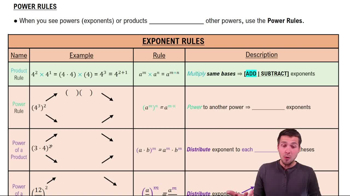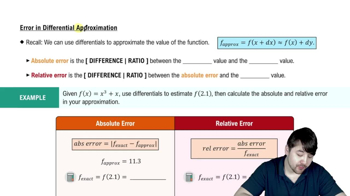Table of contents
- 0. Functions7h 52m
- Introduction to Functions16m
- Piecewise Functions10m
- Properties of Functions9m
- Common Functions1h 8m
- Transformations5m
- Combining Functions27m
- Exponent rules32m
- Exponential Functions28m
- Logarithmic Functions24m
- Properties of Logarithms34m
- Exponential & Logarithmic Equations35m
- Introduction to Trigonometric Functions38m
- Graphs of Trigonometric Functions44m
- Trigonometric Identities47m
- Inverse Trigonometric Functions48m
- 1. Limits and Continuity2h 2m
- 2. Intro to Derivatives1h 33m
- 3. Techniques of Differentiation3h 18m
- 4. Applications of Derivatives2h 38m
- 5. Graphical Applications of Derivatives6h 2m
- 6. Derivatives of Inverse, Exponential, & Logarithmic Functions2h 37m
- 7. Antiderivatives & Indefinite Integrals1h 26m
- 8. Definite Integrals4h 44m
- 9. Graphical Applications of Integrals2h 27m
- 10. Physics Applications of Integrals 2h 22m
4. Applications of Derivatives
Differentials
Problem 4.R.116b
Textbook Question
Cosine limits Let n be a positive integer. Evaluate the following limits.
lim_x→0 (1 - cosⁿ x) / x²
 Verified step by step guidance
Verified step by step guidance1
Recognize that the limit involves a trigonometric function, specifically cosine, raised to the power of n. This suggests that we might need to use a trigonometric identity or series expansion to simplify the expression.
Recall the Taylor series expansion for cos(x) around x = 0: cos(x) ≈ 1 - x²/2 + x⁴/24 - ... . For small values of x, higher-order terms become negligible.
Substitute the Taylor series expansion of cos(x) into the expression 1 - cosⁿ(x). For small x, cosⁿ(x) can be approximated as (1 - x²/2)ⁿ.
Use the binomial expansion for (1 - x²/2)ⁿ to approximate it as 1 - n(x²/2) + higher-order terms. This simplifies the expression 1 - cosⁿ(x) to n(x²/2) for small x.
Substitute this approximation into the limit expression: lim_x→0 (1 - cosⁿ(x)) / x² ≈ lim_x→0 (n(x²/2)) / x². Simplify this expression to find the limit as x approaches 0.
 Verified video answer for a similar problem:
Verified video answer for a similar problem:This video solution was recommended by our tutors as helpful for the problem above
Video duration:
6mPlay a video:
Was this helpful?
Key Concepts
Here are the essential concepts you must grasp in order to answer the question correctly.
Limit of a Function
In calculus, the limit of a function describes the behavior of that function as its input approaches a certain value. It is essential for evaluating expressions that may be indeterminate at specific points, such as when both the numerator and denominator approach zero. Understanding limits allows us to analyze the continuity and behavior of functions near points of interest.
Recommended video:

Limits of Rational Functions: Denominator = 0
Taylor Series Expansion
The Taylor series expansion is a powerful tool in calculus that expresses a function as an infinite sum of terms calculated from the values of its derivatives at a single point. For the cosine function, the expansion around zero is particularly useful, as it provides a polynomial approximation that simplifies the evaluation of limits. This concept is crucial for approximating functions and understanding their behavior near specific points.
Recommended video:

Intro to Transformations
L'Hôpital's Rule
L'Hôpital's Rule is a method for evaluating limits of indeterminate forms, such as 0/0 or ∞/∞. It states that if the limit of f(x)/g(x) results in an indeterminate form, the limit can be found by taking the derivative of the numerator and the derivative of the denominator. This rule is particularly useful in calculus for simplifying complex limit problems, especially when dealing with trigonometric functions.
Recommended video:
Guided course

Power Rules







